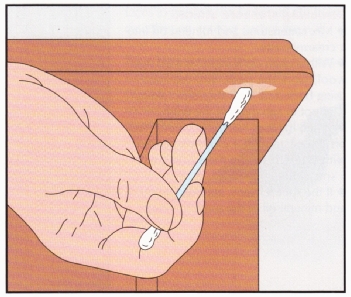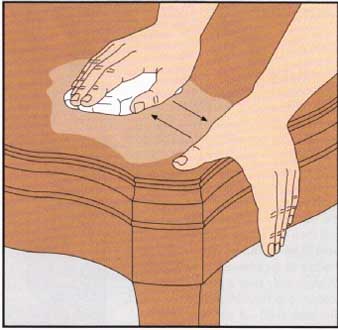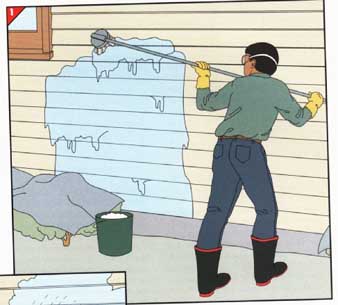Reviving Wood Finishes
| Home | Wiring | Plumbing | Kitchen/Bath |
|
Most wood surfaces are protected by some sort of coating, ranging from clear varnishes on fine paneling to paints that mask the utilitarian woods of interior trim and exterior siding. Methods for cleaning them depend on the type of finish. Paint: Exterior painted surfaces can be scrubbed down by hand (- 15), or by a power washer (-- 26-28). Interior surfaces can be washed with an all-purpose house hold detergent; wring out the cloth or sponge until it’s almost dry. Clear Finishes: Maintain clear finishes on furniture and paneling—including varnish, lacquer, shellac, and oil—by routine polishing and quick cleaning of spills. More rigorous methods are required to restore a faded or discolored finish; spots and blemishes need special treatment (- 14). When the blemish extends to the wood itself, the only solution is to strip the wood and refinish it. Often covered with wax for extra protection, varnish, lacquer, and shellac can be cleaned with a commercial cleaner/polish, usually sprayed on, then lightly rubbed with a soft, lint-free cloth. Use these products sparingly as they can build up over time. An oil finish is best cleaned with a cloth dampened in boiled linseed oil. Pour a small amount of oil into the center of the cloth, then twist the cloth to distribute the oil. Restore a clouded finish by rubbing it with a compatible substance, working in the direction of the grain and taking care not to rub through the finish. For a faded oil finish, combine equal parts of turpentine and boiled linseed oil, then rub the mixture over the entire surface and wipe it away immediately. Allow the wood to stand for two or three days until it’s dry, then re peat the process. Store the oiled cloth in a tightly sealed jar to eliminate the risk of spontaneous combustion. Treat faded varnish, shellac, and lacquer finishes with a cloth dampened in lemon oil. Wipe the surface, moistening the cloth as necessary, until the cloudiness disappears. If the finish is dull after cleaning, apply a coat of paste wax and buff it. Unfinished Wood: Unfinished exterior siding can be scrubbed and rinsed like painted surfaces (- 15). For unfinished interior wood, use a dry sponge (- 42). Unfinished butcher block in the kitchen is a special case, because it’s exposed regularly to water and food. Rub the surface with vegetable oil to seal the wood pores, wipe the wood clean after each use with a damp cloth, and reapply oil occasionally. TOOLS:
Identifying a finish. To determine the type of finish on a piece of furniture, begin by rubbing an inconspicuous spot with a cotton- tipped swab dipped in denatured alcohol; a shellac finish will soften when moistened with alcohol. If the finish remains unaffected, dip a second swab in lacquer thinner and rub it over the surface; a lacquer finish will soften and then dry almost immediately. When neither test dissolves the finish, rub a mixture of turpentine and boiled linseed oil vigorously over a small area; if the mixture can be rubbed into the wood, the finish is oil—if not, it’s varnish. /13 REMOVING SPOTS FROM WOODWORK: Blemish | Treatment Damp cloth | Heavy-duty degreaser | Mineral spirits | #3/0 steel wool | Rottenstone/ mineral oil |
Lifting blemishes from finished wood. Remedies for common problems with wood finishes are provided from left to right in order of increasing strength. Try the weakest cleaner first, proceeding to the next one only if necessary. If the finish is dulled by the treatment, revive it (- 13). Apply a degreaser with a cloth, then wipe the surface clean with a wet cloth and dry it well. To lift a spot from a wood surface with mineral spirits, dip a clean cloth into the sol vent and rub it over the spot; change to a fresh cloth when the old one becomes discolored. If you’re using steel wool, rub the spot lightly, making short back-and-forth passes; always work in the direction of the grain. Remove tough stains with rottenstone or pumice and mineral oil. Removing stubborn stains: • Mix rottenstone and mineral oil into a creamy paste. • With a clean cloth (r) or #3/0 steel wool, work the paste into the spot using back-and-forth motions, taking care not to rub through the finish. • When the spot has disappeared, wipe off the paste with a cloth dampened with water, then dry the surface with a soft cloth. • If the spot remains, apply 3/F pumice and mineral oil in the same manner. /14 SCRUBBING DOWN WOOD SIDING: 1. Applying the cleaner. • Brush coarse dirt off the siding with a wadded cotton cloth. • In a plastic pail, mix 1 gallon of water and cup automatic dishwasher detergent. For unfinished cedar siding, use a commercial cleaner designed specifically for cedar. • Wearing goggles and rubber gloves, use a long-handled, stiff-bristle brush to scrub the siding with long lateral strokes. Work in 5-foot-wide strips from the bottom up; this will prevent dirty water from soaking into dry siding below. To get rid of mildew, first rinse the wall, then mix a solution of 1 quart of chlorine bleach and 1 gallon of water. Test it first by applying some in a hidden spot, then scrub the wall with it. 2. Rinsing away the dirt. • Working from the top down, hose off the washed strip with a strong spray of clear water to remove the loosened dirt and the cleaning solution. • Continue washing and rinsing strips of siding, always washing from bottom to top and rinsing from top to bottom. With each rinse, flush off the adjacent wall surfaces to prevent the loosened dirt from resettling on another part of the wall. For a high-pressure rinse, attach a pressure wand (photograph) to the end of your garden hose. This model has a canister to dispense the cleaning agent as well.
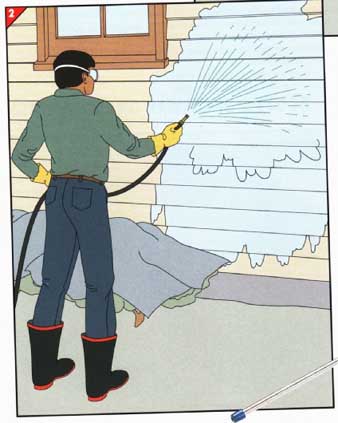 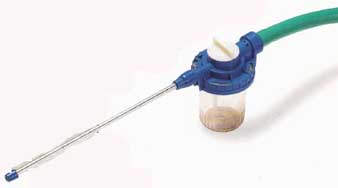
|
| HOME | Prev: An Arsenal of Cleaning Tools | Next: | Article Index |
